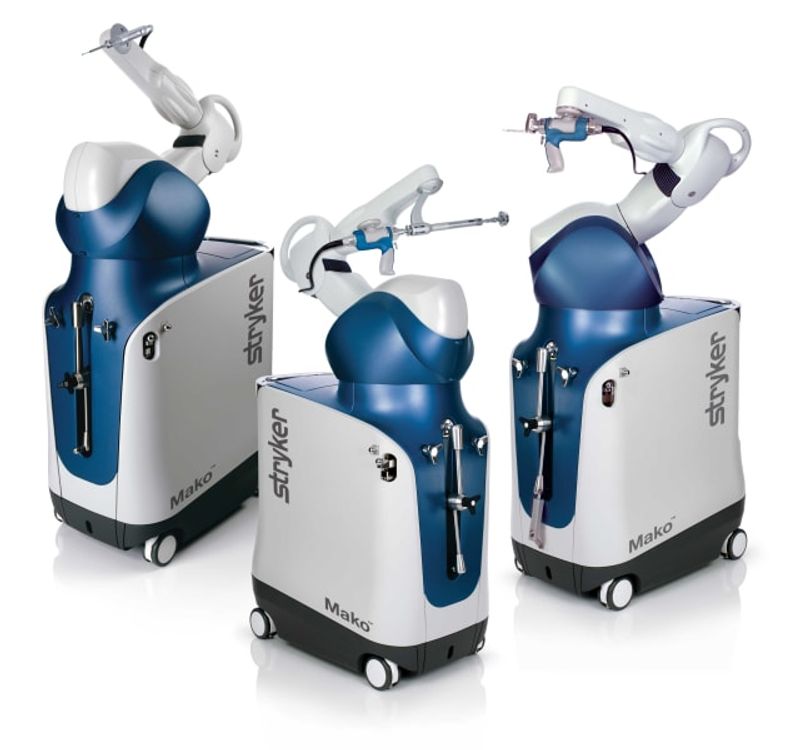Iredell Health System Now Offering Highly Advanced Robotic-Arm Assisted Joint Replacement Surgery with Mako SmartRobotics™

Do you have arthritis or other injuries to your knee or hip? You rely on the joints in your knees and hips every time you stand, sit, or walk. When disease or injury causes pain in these joints, it can feel debilitating and life-changing.
The good news? New, advanced robotic-arm technology can help you get back to doing the things you love.
Iredell Health System is the first hospital in Iredell County to offer Mako SmartRobotics™. This robotic-arm assisted technology transforms how total knee, partial knee, and total hip replacements are performed by helping surgeons know more and cut less.
Mako SmartRobotics is used in hip and knee joint replacement to allow precise placement of implants, optimal for each patient. It also helps protect soft tissues and ligaments in the patient’s joint.
Total knee replacements in the United States are expected to increase by 189% by 2030, yet studies show that 20% of patients are dissatisfied after traditional surgery. The Mako system enables surgeons to have a more predictable surgical experience with increased precision and accuracy. It also helps patients have an easier experience after surgery.
Mako SmartRobotics allows the surgeon to create a personalized plan based on each patient’s unique anatomy before ever entering the operating room. After a Mako surgery, patients experience less pain in the days and weeks following surgery than non-robotic surgery patients.
Dr. Brett Feldman and Dr. Jeffery Reeves, orthopedic surgeons with Piedmont Healthcare, are the utilizers of Iredell’s Mako system.
“It is an exciting technology as it allows dynamic positioning of joint implants in the exact position the surgeon wishes to place them. It gives the surgeon control over the surgery that did not previously exist,” said Reeves.
Studies show that Mako SmartRobotics offers multiple benefits for patients, including:
- Less bone and soft tissue damage
- Less time to hospital discharge
- Less need for in-patient physical therapy sessions
- Less pain after surgery
- Less need for opioid pain medications following the surgery
“Patient outcomes have been terrific. Some of the more challenging issues related to achieving balance and stability in the more difficult cases have been greatly simplified,” said Feldman, who has performed 51 knee replacements and 14 hip replacements using Iredell’s Mako system.
According to Reeves, patients with osteoarthritis, rheumatoid arthritis, post-traumatic arthritis, avascular necrosis, osteonecrosis, or certain types of femoral neck fractures, among others, could be ideal candidates for a Mako surgery.
How does Mako SmartRobotics work?
It all starts with a CT scan. Before surgery, each patient will receive a CT scan of the joint needing replacement. The CT scan combines a series of x-ray images taken at different angles and computers to make a 3D model of the joint. This virtual 3D model is then loaded into the Mako system and used to make a patient-specific plan before the surgery (pre-operative plan).
“Once uploaded into the Mako system, we can accurately predict what size implants will be needed for each joint replacement as well as be able to see how the implants match the specific patient’s anatomy,” said Reeves.
After the surgeon reviews and validates the pre-operative plan, the patient is ready for surgery.
During surgery, Mako SmartRobotics uses special sensors to help the machine know where it is in relation to the patient’s bone. The surgeon registers the patient’s anatomy to the CT scan loaded into the system, allowing Mako to “see” the edges of the bone, which then ensures controlled and precise cutting during the operation.
“By seeing exactly where the saw is cutting on the computer screen, I am able to make the cuts without removing as much surrounding tissue,” said Feldman.
Once the patient’s joint is registered to the Mako system, the surgeon is ready to operate. The surgeon guides Mako’s robotic arm to the diseased bone and cartilage.
Using the pre-operative plan, Mako SmartRobotics creates a virtual boundary, preventing the surgeon from removing any more bone than needed. The robotic arm will only cut places that were previously selected during the pre-operative plan and will not go out of that zone. This preserves more bone and creates a smaller cut.
It’s important to note that although Mako SmartRobotics is a cutting-edge tool, it still relies on the data the surgeon inputs into it, as well as the surgeon to correctly utilize the data it generates.
“Occasionally, patients will wonder, ‘who does the surgery, the robot or the surgeon?’” said Reeves. “The robot merely helps the surgeon execute the plan. The surgeon is in complete control within the boundaries set to make the cut.”
“While there is no substitute for the training and experience of the surgeon, the Mako robotic system reduces the time and effort required to ensure proper balance and alignment of the joint replacement, which is critical to the long-term success of the procedure,” added Feldman.
Learn More
If you are considering joint replacement, you can visit patients.stryker.com for more information and video walkthroughs on Mako SmartRobotics.
If you would like to schedule a consultation with Dr. Jeffrey Reeves or Dr. Brett Feldman at Piedmont Bone & Joint, please call 704-873-3250.
“We are proud to be the first hospital in Iredell County to offer this highly advanced technology in our area. The addition of Mako SmartRobotics further demonstrates our commitment to provide the community with outstanding healthcare,” said John Green, President and CEO of Iredell Health System.
































